

II.2.5 Hydridopalladium Complexes
KING KUOK (MIMI) HII
A. INTRODUCTION
Although hydridopalladium species have often been postulated as important reactive intermediates in a number of reactions, their precise role in catalysis and/or organic chemistry remains a challenging research area. Due to their instability, identification of hydridopalladium species is rare and they have never been detected under true catalytic conditions. In this section, a brief account of the preparation and characterization of hydridopalladium complexes will be given followed by a discussion on their chemical behavior.
Palladium hydrides occurring in clusters, adsorbed surfaces, and interstitial sites will not be included here. Also excluded are reports of proposed structures with no sufficient characterization data.
B. GENERATION AND IDENTIFICATION OF HYDRIDOPALLADIUM COMPLEXES
B.i. Background
To date only a limited number of hydridopalladium complexes have been successfully isolated and characterized unequivocally. The different synthetic routes, as well as structural, spectral, and theoretical studies of discrete hydridopalladium species, have been reviewed extensively in 1996.[1] With the notable exception of the unusual zerovalent complexes[2] (such as [PdH4]2 ), almost all of the hydridopalladium complexes reported so far have been monohydride complexes coordinated by phosphine ligands.
B.ii. Hydridopalladium Complexes trans-[(R3P)2Pd(H)(X)(PR3)2]
This class of hydridopalladium species are the best characterized, especially those containing bulky phosphine ligands. The coordination of these bulky phosphine ligands stabilizes the hydride species in two ways. First, the basicity of the metal center usually increases with steric bulk; and second, the bulkier phosphines are more likely to adopt a trans configuration, thus reducing the chance of decomposition via the elimination of HX.
Handbook of Organopalladium Chemistry for Organic Synthesis, Edited by Ei-ichi Negishi ISBN 0-471-31506-0 © 2002 John Wiley & Sons, Inc.
81
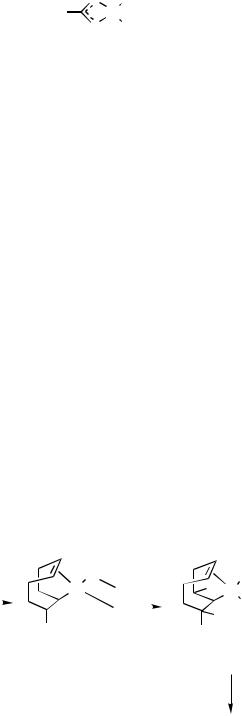
82 |
II Pd-COMPOUNDS: STOICHIOMETRIC PREPARATION |
|
|
S |
PEt3 |
|
Me2N |
Pd |
S H
Figure 1
The first hydridopalladium complexes to be isolated and characterized in pure form[3] were the trans-[(R3P)2Pd(H)(X)] complexes (where PR3 tertiary phosphines, X anionic ligands), and they still represent the largest class of isolated hydridopalladium complexes.
The most common ways to prepare hydridopalladium complexes of the type trans- [(R3P)2Pd(H)(X)] are:
1. Addition of HCl or trifluoroacetic acid to coordinatively unsaturated palladium(0) complexes [Pd(PR3)x][4]–[8] (PR3 PMe3, PPh3, PMePh2, PCy3, PtBu3, PtBu2Ph, PiPr3;
and x 2, 3 or 4) or [(R P) Pd(olefin)][9],[10] (PR P(CH Ph) , PMePh , PEtPh , PEt Ph; |
|||||||||||||
|
|
3 |
2 |
|
|
|
3 |
2 |
3 |
2 |
2 |
|
2 |
olefin ethylene, styrene, |
or |
methyl |
methacrylate). Other |
“acidic” protons |
could |
react |
|||||||
with |
palladium(0) |
complexes |
to give |
the |
oxidatively |
added |
palladium(II) |
species. |
|||||
The |
first example |
was the addition |
of |
a |
terminal |
acetylene |
to [Pd(PPh3)4] |
to |
give |
||||
[(Ph3P)2Pd(H)(C#CR)].[11] Although this complex was prepared in the 1970s, its 1H NMR was only verified independently in 1991.[10] The addition of O—H bonds of phenol[12] and pentafluorophenol[13] to bis (tricyclohexylphosphine)palladium(0) furnished trans- [(Cy3P)2Pd(H)(OAr)] ArOH whereas the addition of ArSH[14] (Ar Ph, p-MeC6H4, p-MeOC6H4) also proceeded smoothly to give the thiolato complexes [(Cy3P)2Pd(H)(SAr)].
2.Reduction of the corresponding palladium halide complex by Me3GeH,[3] NaBH4,[15] or LiHBEt3 (Super-Hydride)[16]; the later has been found to be particularly useful in the preparation of thermally unstable hydrides, such as the [(Me2NNCS2)Pd(H)(PEt3)] complex (Figure 1).
3.Hydrogenolysis[17] of trans-[(Ph3P)2Pd(COPh)(X)] or trans-[(PPh3)2Pd(Ph)(X)] under high pressure (80 atm) at 60 °C.
4.-Hydride elimination processes. An important reaction in many Pd-catalyzed reactions, this is nevertheless the least common method for preparing hydridopalladium complexes. First reported by Maitlis and co-workers[18],[19] a simpler procedure was developed by Goel and
Goel[20] to generate a range of [L2Pd(H)(Cl)] complexes from [(COD)PdCl2] (Scheme 1).
|
|
|
|
|
|
|
|
|
|
|
|
|
|
+ |
|
|
|
|
|
|
Cl |
|
|
|
|
H Pd |
L |
|
|
||
Pd(COD)Cl2 NaOH, |
|
|
Pd |
|
+2 L |
|
|
|
Cl |
− |
|||||
|
|
|
|
|
|
L |
|
||||||||
|
MeOH |
|
|
|
|
|
|
|
|
|
H |
|
|
||
|
|
|
|
|
|
|
|
|
|
|
|||||
|
|
|
|
|
|
|
|
|
|
|
|
||||
|
|
|
|
OMe |
|
|
2 |
|
|
|
|
|
|
|
|
|
|
|
|
|
|
|
|
|
OMe |
|
|
|
|
||
|
|
|
|
|
|
|
|
|
|||||||
(L = PCy3, PiPr3, PtBu2Me, PtBu2nBu)
[L2Pd(H)Cl]
Scheme 1
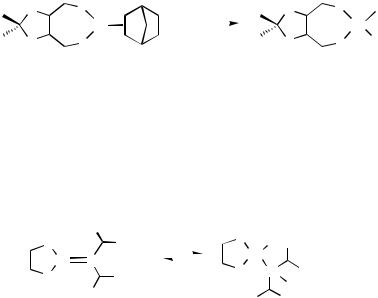
II.2.5 HYDRIDOPALLADIUM COMPLEXES |
83 |
B.iii. Hydridopalladium Complexes cis-[(R3P)2Pd(H)X]
Due to the ease of reductive elimination of HX, there are only two reported examples of cis-[(diphosphine)Pd(H)(X)] complexes. The addition of HCN to [(diop)Pd(norbornene)] generated a transient intermediate that has been formulated as a [(diop)Pd(H)(CN)] complex[21] (Scheme 2), suggested by the observation of a broad proton resonance at 4.9 ppm in the 1H NMR spectrum.
O |
Ph2 |
|
|
O |
Ph2 |
H |
P |
|
HCN |
P |
|||
O |
Pd |
|
|
O |
Pd |
CN |
|
|
|||||
P |
|
|
P |
|||
|
Ph2 |
|
|
|
Ph2 |
|
|
|
Scheme 2 |
|
|
|
|
The other example is a bimetallic compound in which ROH (R H or Me) adds reversibly to [(R 2PCH2CH2PR 2)Pd"Sn{CH(TMS)2}2] (R iPr, iBu), giving [(R 2PCH2CH2PR 2)Pd(H){Sn(OR){CH(TMS)2}2}], which is stable up to 100 °C, whereby it eliminates a molecule of the protic solvent, reverting back to the initial starting material (Scheme 3).[22]
R′2 |
|
TMS |
|
|
|
R′2 |
|
|
|
TMS |
+ROH |
P |
H TMS |
||||
P |
|
|||||||
Pd |
Sn |
|
|
|
Pd |
|
||
|
|
|
|
|||||
−ROH |
P |
Sn TMS |
||||||
P |
|
TMS |
||||||
|
|
|
|
R′2 |
OR |
|||
R′2 |
TMS |
|
|
|
TMS |
TMS |
||
|
|
|
|
|
|
|||
(R′ = iPr, tBu)
Scheme 3
B.iv. Cationic Hydridopalladium Complexes [(R3P)3Pd(H)] X
Dihydrogen reacts with [(Ph3P)2Pd(CF3COO)2] complex at 70 °C, in the presence of excess triphenylphosphine and aqueous CF3COOH, to give the cationic palladium hydride complex [(Ph3P)3Pd(H)] . This complex could also be prepared by the addition of the acid to [Pd(PPh3)4] at 25 °C. The structure was confirmed by 1H and 31P NMR studies.[23]
Protonation of tetrakis(triethylphosphine)palladium(0) by ethanol gave the cationic hydridopalladium complex [Pd(H)(PEt3)3] , isolated as a tetraphenylborate salt.[24] Addition of strong acids H3O X (X BF3OH, BF4) to coordinatively unsaturated 14-elec- tron palladium complexes [Pd(PR3)2] (R tBu[25], Cy[26]) gave thermally unstable cationic hydridopalladium complexes trans-[(R3P)2Pd(H)(H2O)]X. These could be made more stable through the coordination of a better donor solvent such as acetonitrile [(R3P)2Pd(H)- (CH3CN)]X. Interestingly, the stability of these complexes is dependent on the interaction between the coordinated solvent molecule with the counteranion. In light of this, the ability of the palladium hydride to engage in hydrogen bonding was discussed.[26]
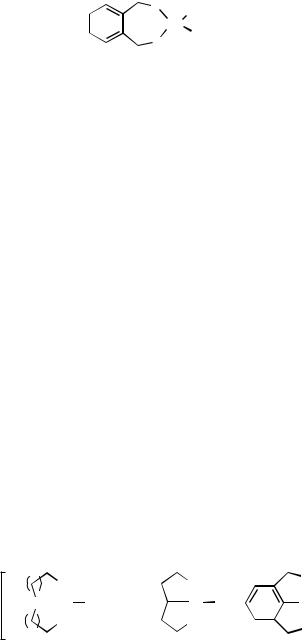
84 |
II Pd-COMPOUNDS: STOICHIOMETRIC PREPARATION |
|
||||||
|
|
|
|
R2 |
|
|
+ |
|
|
|
|
|
|
|
|
||
|
|
|
|
P |
H |
|
|
|
|
|
|
|
|
Pd |
|
BF |
− |
|
|
|
|
P |
S |
4 |
||
|
|
|
|
|
|
|||
|
|
|
|
R2 |
|
|
|
|
(R = tBu, S = MeOH)
Figure 2
Recently, a [(diphosphine)Pd(H)(MeOH)][BF4] (Figure 2) has also been prepared by the addition of HBF4 to [(diphosphine)Pd(dba)] in the presence of oxygen or benzoquinone.[27]
B.v. Other Hydridopalladium(II) Complexes
So far, the most stable hydridopalladium complexes are those that are chelated by tridentate ligands containing phosphorus donors (Figure 3). [Pd(triphosphine)(CH3CN)](BF4)2 complexes reacts with NaBH4 or H2 to form [Pd(triphosphine)(H)](BF4), where triphosphine ttpE, ttpC, eptpE, etpE, and etpC.[28] Hydridopalladium complexes chelated by PCP ligands[29],[30] are found to have unusual thermal stability where the cis-phosphorus donor atom contains sterically bulky groups, that is, when R tBu. Reducing the steric bulk (when R Ph) is found to reduce the stability of the complex.[31] The methylpalladium hydrides trans-[L2Pd(Me)(H)] (L PCy3, PiPr3) were prepared by the reaction of Grignard reagent MeMgBr with the corresponding chloro complex [L2Pd(H)(Cl)].[32]
The synthesis of other trans-[L2Pd(H)(X)] complexes, where X I or Br, NO3, CN or NCS, BH4, RC#C, and PhNH, have also been reported.[10],[33]–[36]
The replacement of an anionic ligand by a neutral ligand is also a convenient way of generating cationic palladium complexes of the general formula [(R3P)2Pd(H)(L)] A (where R Cy, iPr or Me; L dppe, MeCN, pyrazole, imidazole, pyridine, and substituted pyridines; A PF6 or BPh4).[34]
The formation of hydridopalladium complexes free of phosphine ligands (Figure 4) were observed when cyclometalated palladium chloride complexes were subjected to hydrogenolysis in DMF solutions.[37]
|
|
|
|
|
|
+ |
|
t |
Bu2 |
|
|
PR2 |
|||
|
|
|
|
|
|
|
|
|
|
||||||
|
|
|
|
|
|
|
|
|
|
|
|||||
|
|
x |
|
PR2 |
|
P |
|
|
|
|
|
||||
|
|
|
BF−4 |
|
|
|
|
|
|
|
|
||||
|
|
|
|
|
|
|
|||||||||
Ph |
|
P |
|
|
Pd H |
|
Pd H |
|
Pd |
|
H |
||||
|
|
|
|
|
|
||||||||||
|
|
|
|
|
|
|
|
|
|
|
|
|
|
|
|
|
|
y |
|
PR2 |
|
PtBu2 |
|
|
|
|
|
||||
|
|
|
|
PR2 |
|||||||||||
|
|
|
|
|
|
|
|
|
|
|
|
||||
x = 2, y = 2, R = Et; ttpE x = 2, y = 2, R = Cy; ttpC x = 1, y = 2, R = Et; eptpE x = 1, y = 1, R = Et; etpE x = 1, y = 1, R = Cy; etpC
Figure 3
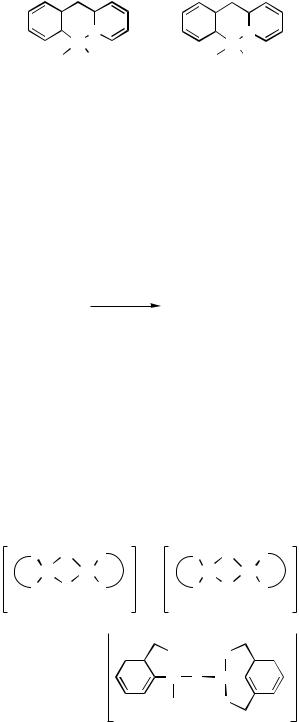
|
|
|
|
II.2.5 |
HYDRIDOPALLADIUM COMPLEXES 85 |
|||||
|
|
|
|
|
|
|
O |
|||
|
|
N |
|
|
|
|
|
|
N |
|
|
|
|
|
|
|
|
|
|
||
|
|
|
|
|
|
|
|
|
||
|
|
|
|
|
|
|
|
|||
|
|
Pd |
|
|
Pd |
|||||
S |
H |
S |
|
|
H |
|||||
(S = DMF)
Figure 4
The only example of a dihydride complex, trans-[(Cy3P)2Pd(H)2],[38] is formed by the reduction of bis(acetoacetonate)palladium(II) with trialkylaluminum in the presence of PCy3 (Scheme 4). Its structure is deduced by analogy to the corresponding characterized platinum dihydride complex. The isolated product was reported to have an unusually low (Pd 9H) infrared band; the authors ascribed this to the strong trans effect of the hydride ligands. However, the insolubility of the complex precludes any definitive NMR examination.
AlR3
Pd(acac)2 + 2 PCy3 [Pd(H)2(PCy3)2] + [Pd(PCy 3)2]
Et2O
Scheme 4
B.vi. Hydridopalladium(IV) Complexes
Of particular interest is the report of a reversible addition of nonactivated aliphatic and aromatic C—H bonds, including p-xylene, toluene, benzene, n-hexane, and cyclohexane, to [(Ph3P)2PdX2] (X Cl, Br, I), giving the palladium(IV) complexes [(Ph3P)2PdX2(R)(H)].[39]
Hydride ligand may also adopt a -coordination mode (Figure 5) whereby it bridges to two palladium centers. [(Diphosphine)Pd}2( -H)( -CO)] is probably the most common binuclear hydridopalladium complex reported (where P2 monodentate[23] or bidenphosphine ligands) often by the reaction of a 14-electron coordinatively
P |
|
H |
P |
+ |
|
P |
|
H |
|
P |
+ |
|||||||
|
Pd |
|
Pd |
|
|
|
|
Pd |
|
Pd |
|
|
|
|||||
|
C |
|
|
|
|
H |
|
|
|
|||||||||
P |
|
P |
|
|
|
P |
|
|
P |
|
|
|
||||||
|
|
|
|
|
|
|
|
|
|
|
|
|
|
|
|
|
|
|
|
|
O |
|
|
|
|
|
|
|
|
|
|
|
|
|
|
||
|
|
|
|
|
|
|
|
|
|
|
PPh2 |
Ph2P |
|
|
|
|
+ |
|
|
|
|
|
|
|
|
|
|
|
|
|
|
|
|||||
|
|
|
|
|
|
|
|
|
|
|
|
|
|
|
|
|||
|
|
|
|
|
|
|
|
|
|
|
|
|
|
|
|
|
|
|
Pd H Pd
 PPh2 Ph2P
PPh2 Ph2P
Figure 5
86 |
II Pd-COMPOUNDS: STOICHIOMETRIC PREPARATION |
unsaturated palladium complex with carbon monoxide in methanolic solution. Other complexes containing a single hydride bridge[26] or dihydride bridges[43]–[45] are also known. Although the involvement of dinuclear palladium complexes as reactive intermediates in catalytic processes has yet to be proved, the possibility could not be entirely ruled out.
C. CHARACTERIZATION OF HYDRIDOPALLADIUM COMPLEXES
Although the stereochemistry of transition metal hydrides is generally well studied,[46] the limited number and variety of isolated hydridopalladium complexes hinder systematic studies. So far none of the palladium hydride complexes has been examined by neutron diffraction techniques, although a number of solid-state X-ray crystallographic structures have been reported.[12],[13],[26],[45] Since X-rays are scattered by M—H bonding electrons and not the nuclei, the exact position of the hydride ligand could not be located. Generally, palladium–hydride bond distances are thought to be between 1.46 and 2.13 Å, and it has been suggested that “X-ray methods systematically underestimate the true M—H internuclear distance by approximately 0.1 Å”.[47]
Infrared and 1H NMR spectroscopy are invaluable ways of characterizing hydridopalladium complexes in the solution phase, especially for transient and/or unstable species. Although terminal hydride ligands are expected to have (Pd9H) stretches occurring in the distinctive region of 1950 – 2060 cm 1 in the infrared spectrum, they are often very weak signals and are also rather dependent on the trans effect of the opposite ligand. Therefore, this should not be used as the sole characterization technique. The most reliable way of determining the presence of a hydride ligand is by 1H NMR spectroscopy. The Pd9H signal is deshielded by its coordination to a transition metal and is located at higher field than the TMS signal (referenced at 0 ppm). Its precise chemical shift is again dependent on the trans ligand: around 5 ppm if it is trans to a carbon fragment, or in the region of 15 to 20 ppm if it is trans to an electronegative ligand, such as a halide or an alkoxide.
D. CHEMICAL BEHAVIOR OF HYDRIDOPALLADIUM COMPLEXES
The broad reactivity pattern displayed by transition metal hydrides is of special relevance in catalytic reactions[48] and has led to a great deal of theoretical studies.[49] The organometallic chemistry of hydridopalladium complexes has been reviewed.[50] The involvement of hydridopalladium species is prevalent in Pd-catalyzed reactions. Their precise roles in catalytic hydrogenation (Sect. VII), Tsuji – Trost (Sect. V.2.1), and other related reactions are covered in detail in later sections. Only a brief introduction to their general reactivity of mechanistic relevance will be presented here.
D.i. General Reactions
The precise nature of the Pd — H bond is an interesting issue that seems to depend largely on the nature of the other ligands bound to palladium. For a series of [Pd(triphosphine)(H)](BF4) complexes, the hydridic/acidic nature of the hydride ligand has been investigated via reactivity studies and extended Hückel calculations, which showed a
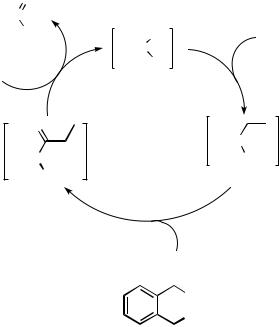
II.2.5 HYDRIDOPALLADIUM COMPLEXES |
87 |
correlation between the chelate bite angles and electron density on the hydride ligand.[20] Much of the chemistry of hydridopalladium complexes could broadly be divided into two types:
1. The addition of the Pd—H bond across unsaturated carbon–carbon bonds such as alkenes and alkynes.[16] This constitutes the initial steps of many proposed catalytic cycles catalyzed by palladium. More often than not the hydridopalladium complexes are generated in situ by the addition of a proton source (e.g., acetic acid or acidic hydroxyl substrates) to palladium(0). The nature of the hydride ligand on palladium and the subsequent implications in organic synthesis have been reviewed.[51] Intermolecular assemblies of olefins, alkynes, allenes, carbon monoxide, amines, or oxygen nucleophiles have been achieved.[52] The resultant Pd—C bond can then participate in a range of reactions such as insertion into another unsaturated molecule or coupling with saturated fragments. This is demonstrated well by the Pd-catalyzed methoxycarbonylation of ethene, which has been shown to occur via a hydride mechanism, by the identification of all the reactive intermediates involved in the catalytic cycle (Scheme 5).[27]
O |
|
|
C2H5C |
H + |
|
OMe |
C2H4 |
|
|
L2Pd |
|
|
S |
|
MeOH
+
O +
L2Pd
L2Pd |
S |
S
CO
PtBu2
L2 =
PtBu2
Scheme 5
2. The study of the involvement of hydridopalladium complexes under basic conditions is far more elusive. The involvement of these species in the -hydrogen elimination step has never been observed directly and their involvement is only implied based on mechanistic considerations. A good example was provided by studies of the reductive elimination step of the Heck arylation reaction. An alkylpalladium(II) intermediate releases the product methyl cinnamate, while simultaneously capturing a
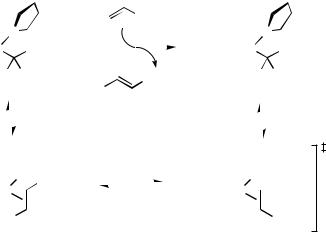
88 |
II Pd-COMPOUNDS: STOICHIOMETRIC PREPARATION |
methyl acrylate in the process to form the alkyl complex (Scheme 6).[53] The process is very facile, presumably occurring via a transient hydridopalladium complex, which was not observed but must clearly be involved. In the presence of base that is likely to deprotonate the hydridopalladium species, the catalytic precursor is generated instead.
CF3SO3− |
|
|
|
|
|
|
|
|
|
|
|
CO2Me |
|
CF3SO3− |
|
||||||
|
|
|
|
|
|
|
|
|
|
|
|
|
|
|
|
|
|
||||
+ |
O |
|
|
|
|
|
|
|
|
|
|
|
|
|
|
+ |
|
O |
|||
|
|
|
|
|
|
|
|
|
|
|
|
|
|
|
|
|
|
|
|||
|
P2Pd |
|
|
CH2Ph |
|
|
|
|
|
|
|
|
|
|
|
P2Pd |
CH3 |
||||
|
|
|
|
|
|
|
|
|
|
|
|
||||||||||
|
MeO2C |
|
|
H |
|
|
|
|
|
|
|
|
CO2Me |
|
MeO2C |
H |
|||||
|
|
|
|
|
|
|
|
|
|
|
Ph |
|
|
|
|
|
|||||
|
|
|
|
|
|
|
|
|
|
|
|
|
|
|
|
|
|
|
|
|
|
|
|
|
|
|
|
|
|
|
|
|
|
|
|
|
|
|
|
|
|
|
|
|
|
|
|
|
|
|
|
|
|
|
|
|
|
|
|
|
|
|
|
|
|
|
|
|
|
|
|
|
|
|
|
|
|
|
|
|
|
|
|
|
|
|
|
|
CF3SO3− |
H |
|
|
|
|
|
|
|
|
|
|
|
|
|
CF3SO3− |
H |
|
|||
|
|
|
|
|
|
|
|
|
|
|
|
|
|
|
|||||||
+ |
|
|
Ph |
|
|
|
|
|
|
|
|
|
|
+ |
|
||||||
|
|
|
|
|
|
|
|
|
|
|
|
|
|
|
|
||||||
|
P2Pd |
|
|
|
|
|
|
|
|
|
|
|
|
|
|
|
|
P2Pd |
|
|
CO2Me |
|
|
|
|
|
|
|
|
|
|
|
|
|
|
|
|
|
|||||
|
MeO2C |
|
|
|
|
|
|
|
|
|
|
|
|
|
|
|
|
|
|||
|
|
|
|
|
|
|
|
|
|
|
|
|
Scheme 6 |
|
|
|
|
|
|||
|
|
|
|
|
|
|
|
|
|
|
|
|
|
|
|
|
|
||||
Subsequent studies on the reactivities of neutral and cationic alkyland arylpalladium complexes revealed that the creation of a vacant site adjacent to the alkyl or aryl ligand causes marked enhancement in reactivity toward -hydrogen migration.[54] The implications of these results on the fundamental processes of the transition metal alkyls and aryls with the mechanisms of Pd-catalyzed organic synthesis, such as arylation of olefins and carbonylation of aryl halides, have been discussed.
E. FUTURE OUTLOOK
The effort to identify the precise role of hydridopalladium species in catalytic reactions could not be underestimated. There is a need for a systematic study of the precise nature of these transient species. The task will be a very challenging one but will invariably lead to improvements in current protocols, as well as the design of novel catalytic reactions.
REFERENCES
[1]V. V. Grushin, Chem. Rev., 1996, 96, 2011–2033.
[2]M. Olofsson-Mårtensson, M. Kritikos, and D. Noréus, J. Am. Chem. Soc., 1999, 121, 10908.
[3]E. H. Brooks and F. Glockling, J. Chem. Soc. A, 1967, 1030.
[4]H. Werner and W. Bertleff, Chem. Ber., 1983, 116, 823.
II.2.5 HYDRIDOPALLADIUM COMPLEXES |
89 |
[5]K. Kudo, M. Hidai, T. Murayama, and Y. Uchida, J. Chem. Soc. Chem. Commun., 1970, 1701.
[6]R. van der Linde, and R. O. de Jongh, J. Chem. Soc. Chem. Commun., 1971, 563.
[7]T. Yoshida and S. Otsuka, J. Am. Chem. Soc., 1977, 99, 2134.
[8]H. C. Clark, A. B. Goel, and S. Goel, Inorg. Chem., 1979, 18, 2803.
[9]F. Ozawa, T. Ito, Y. Nakamura, and A. Yamamoto, J. Organomet. Chem., 1979, 168, 375.
[10]A. L. Seligson, R. L. Cowan, and W. C. Trogler, Inorg. Chem., 1991, 30, 3371.
[11]G. A. Chukhadzhyan, Z. K. Evoyan, and L. N. Melkonyan, Zh. Obshch. Khim., 1975, 45, 1114; J. Gen. Chem. USSR (English Transl.), 1975, 45, 1096.
[12]D. Braga, P. Sabatino, C. Di Bugno, P. Leoni, and M. Pasquali, J. Organomet. Chem., 1987, 334, C46.
[13]C. Di Bugno, M. Pasquali, P. Leoni, and P. Sabatino, and D. Braga, Inorg. Chem., 1989, 28, 1390.
[14]K. Osakada, H. Hayashi, M. Maeda, T. Yamamoto, and A. Yamamoto, Chem. Lett., 1986, 597.
[15]T. Saito, H. Munakata, and H. Imoto, Inorg. Synth., 1977, 17, 83.
[16]D. L. Reger and D. G. Gaza, Organometallics, 1993, 12, 554.
[17]B. T. Heaton, S. P. A. Hébert, J. A. Iggo, F. Metz, and R. Whyman, J. Chem. Soc. Dalton Trans., 1993, 3081.
[18]T. Hosokawa and P. M. Maitlis, J. Am. Chem. Soc., 1972, 94, 3238.
[19]D. J. Mabbott and P. M. Maitlis, J. Chem. Soc. Dalton Trans., 1976, 2156.
[20]A. B. Goel and S. Goel, Inorg. Chim. Acta, 1980, 45, L85.
[21]M. Hodgson, D. Parker, R. J. Taylor, and G. Ferguson, Organometallics, 1988, 7, 1761.
[22]F. Schager, K. Seevogel, K.-R. Porschke, M. Kessler, and C. Kruger, J. Am. Chem. Soc., 1996, 118, 13075.
[23]V. N. Zudin, V. D. Chinakov, V. M. Nekipelov, V. A. Likholobov, and Yu. I. Yermakov,
J. Organomet. Chem., 1985, 289, 425.
[24]R. A. Schunn, Inorg. Chem., 1976, 15, 208.
[25]M. Sommovigo, M. Pasquali, P. Leoni, P. Sabatino, and D. Braga, J. Organomet. Chem., 1991, 418, 119.
[26]P. Leoni, M. Sommovigo, M. Pasquali, S. Midollini, D. Braga, and P. Sabatino, Organometallics, 1991, 10, 1038.
[27]G. R. Eastham, B. T. Heaton, J. A. Iggo, R. P. Tooze, R. Whyman, and S. Zacchini, Chem. Commun., 2000, 609.
[28]S. A. Wander, A. Miedaner, B. C. Noll, R. M. Barkley, and D. L. DuBois, Organometallics, 1996, 15, 3360.
[29]C. J. Moulton and B. L. Shaw, J. Chem. Soc. Dalton Trans., 1976, 1020.
[30]L. Seligson and W. C. Trogler, Organometallics, 1993, 12, 738.
[31]H. Rimml and L. M. Venanzi, J. Organomet. Chem., 1984, 260, C52.
[32]L. Abis, R. Santi, and J. Halpern, J. Organomet. Chem., 1981, 215, 263.
[33]M. L. H. Green, H. Munakata, and T. Saito, J. Chem. Soc. A, 1971, 469.
[34]H. Imoto, H. Moriyama, T. Saito, and Y. Sasaki, J. Organomet. Chem., 1976, 120, 453.
[35]H. Munakata and M. L. H. Green, Chem. Commun., 1970, 881.
[36]H. Munakata and T. Saito, Inorg. Synth., 1977, 17, 88.
[37]A. Bose and C. R. Saha, Indian J. Chem., 1990, 29, 461.
[38]K. Kudo, M. Hidai, and Y. Uchida, J. Organomet. Chem., 1973, 56, 413.
90II Pd-COMPOUNDS: STOICHIOMETRIC PREPARATION
[39]A. N. Vedernikov, A. I. Kuramshin, and B. N. Solomonov, J. Chem. Soc. Chem. Commun., 1994, 121.
[40]M. Portnoy and D. Milstein, Organometallics, 1994, 13, 600.
[41]I. Tóth and C. J. Elsevier, Organometallics, 1994, 13, 2118.
[42]M. Sperrle, V. Gramlich, and G. Consiglio, Organometallics, 1996, 15, 5196.
[43]M. D. Fryzuk, B. R. Lloyd, G. K. B. Clentsmith, and S. J. Rettig, J. Am. Chem. Soc., 1991, 113, 4332.
[44]Y. Pan, J. T. Mague, and M. J. Fink, Organometallics, 1992, 11, 3495.
[45]M. D. Fryzuk, B. R. Lloyd, G. K. B. Clentsmith, and S. J. Rettig, J. Am. Chem. Soc., 1994, 116, 3804.
[46]J. P. Jesson, In Transition Metal Hydrides, E. L. Muetterties, Ed., Marcel Dekker, New York 1971, Vol. 1, Chap. 4, 75 – 201.
[47]R. H. Crabtree, In The Organometallic Chemistry of the Transition Metals, 2nd ed., Wiley, New York, 1994, Chap. 3, 44 – 71.
[48]D. W. Slocum and W. R. Moser, Eds., Catalytic Transition Metal Hydrides, New York Academy of Sciences, New York, 1983.
[49]A. Dedieu, Ed., Transition Metal Hydrides, VCH, New York, 1991.
[50]D. M. Roundhill, Adv. Organomet. Chem., 1975, 13, 273–361.
[51]B. M. Trost, Chem. Eur. J., 1998, 4, 2405–2412.
[52]R. Grigg, M. Monteith, V. Sriharan, and C. Terrier, Tetrahedron, 1998, 54, 3885.
[53]J. M. Brown and K. K. Hii, Angew. Chem. Int. Ed. Engl., 1996, 35, 657.
[54]A. Yamamoto, J. Organomet. Chem., 1995, 500, 337.
